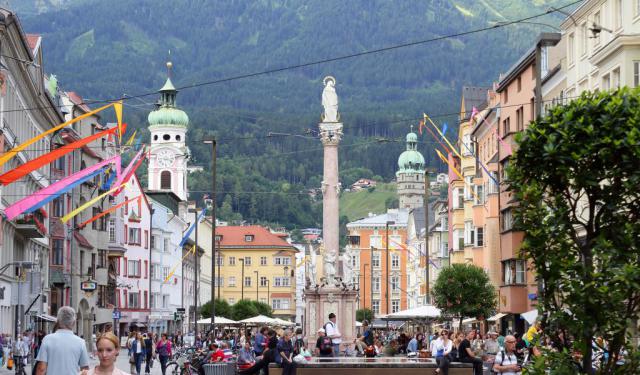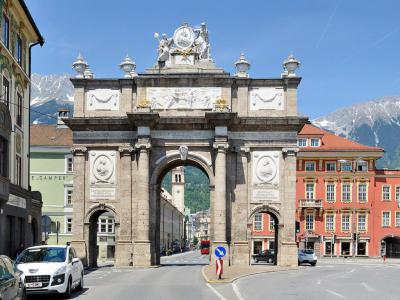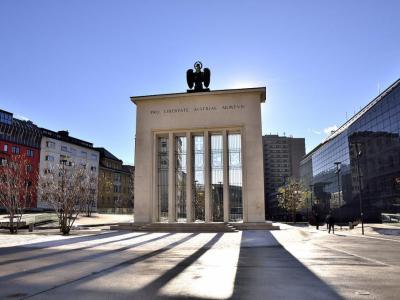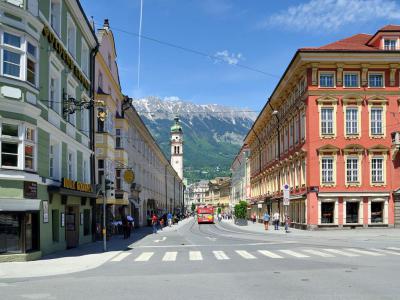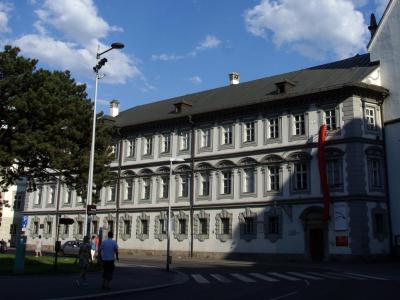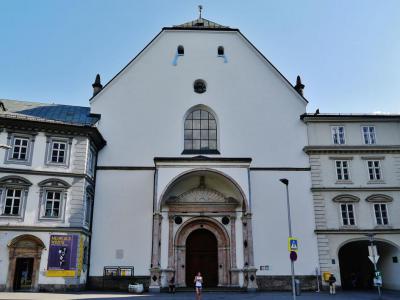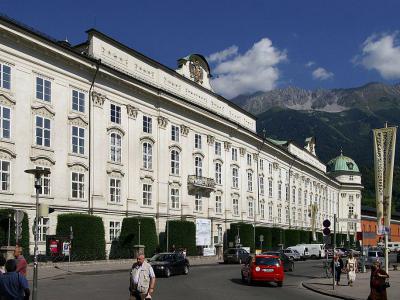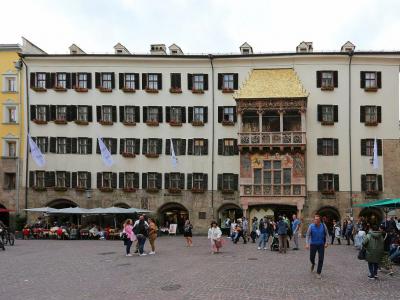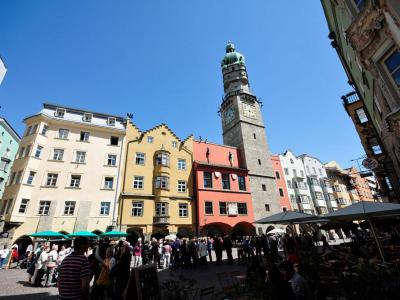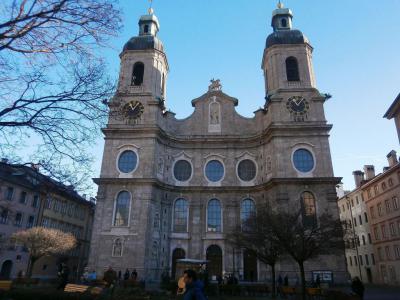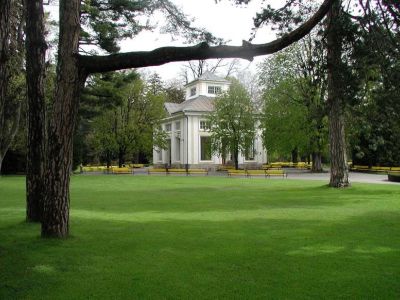Innsbruck Introduction Walking Tour (Self Guided), Innsbruck
Innsbruck is the capital of Tyrol, Austria. It lies in a broad valley on the river Inn, not far from the Brenner Pass. The name "Innsbruck" means "Bridge over the Inn." In the 4th century Romans established a military outpost there, calling it "Bridge over the Oeni" ("Oeni Pontum" in Latin).
In 1180 the Counts of Andechs took over the town. The Brenner Pass was a vital link to northern and southern Europe. The city prospered, charging fees as a transit station on the Imperial Way. The Counts of Andechs were supplanted by the Counts of Tyrol in 1348. The new Counts were the Habsburgs, rulers of the Holy Roman Empire until 1806.
As the capital of Tyrol, Innsbruck became the residence of Emperor Maximilion I. The Court Church (Hofkirche), a classic German Gothic "hall" church, was built in 1584 to hold the cenotaph of Maximilion I and 28 statues of his ancestors. The Imperial Palace (Hofburg) was, for years, the home of the Habsburg Dynasty.
Maria-Theresia, Empress, and her husband, Francis Stephen, are stand out figures in the history of Innsbruck. She ordered the triumphal arch of Innsbruck to celebrate the marriage of her son and to mourn Francis, who died after the wedding in 1765.
The main road of the suburb of Neustadt became Maria-Theresien-Strasse in 1873. It is the most popular shopping street in Innsbruck and the home of the Column of St. Anna, a monument to commemorate the end of Bavarian occupation in 1703.
Watching tournaments in the shade of the Golden Roof was a favorite pastime of Maximilion I in 1493. Now tourists can view events from under the Golden Roof. Another adventure is to climb the the Town Tower (Stadttrum). It requires a love of steps and heights.
Onion-domed St James Cathedral, built to withstand earthquakes in 1724, harbors the masterpiece painting, Mary of Succor, by Lucas Cranach the Elder.
There are too many churches, monuments and museums to mention in this little space. When the walking tour is over, go to the Court Garden (Hofgarten). It is a 600 year old park. Maria Theresia was once a gardener there.
In 1180 the Counts of Andechs took over the town. The Brenner Pass was a vital link to northern and southern Europe. The city prospered, charging fees as a transit station on the Imperial Way. The Counts of Andechs were supplanted by the Counts of Tyrol in 1348. The new Counts were the Habsburgs, rulers of the Holy Roman Empire until 1806.
As the capital of Tyrol, Innsbruck became the residence of Emperor Maximilion I. The Court Church (Hofkirche), a classic German Gothic "hall" church, was built in 1584 to hold the cenotaph of Maximilion I and 28 statues of his ancestors. The Imperial Palace (Hofburg) was, for years, the home of the Habsburg Dynasty.
Maria-Theresia, Empress, and her husband, Francis Stephen, are stand out figures in the history of Innsbruck. She ordered the triumphal arch of Innsbruck to celebrate the marriage of her son and to mourn Francis, who died after the wedding in 1765.
The main road of the suburb of Neustadt became Maria-Theresien-Strasse in 1873. It is the most popular shopping street in Innsbruck and the home of the Column of St. Anna, a monument to commemorate the end of Bavarian occupation in 1703.
Watching tournaments in the shade of the Golden Roof was a favorite pastime of Maximilion I in 1493. Now tourists can view events from under the Golden Roof. Another adventure is to climb the the Town Tower (Stadttrum). It requires a love of steps and heights.
Onion-domed St James Cathedral, built to withstand earthquakes in 1724, harbors the masterpiece painting, Mary of Succor, by Lucas Cranach the Elder.
There are too many churches, monuments and museums to mention in this little space. When the walking tour is over, go to the Court Garden (Hofgarten). It is a 600 year old park. Maria Theresia was once a gardener there.
How it works: Download the app "GPSmyCity: Walks in 1K+ Cities" from Apple App Store or Google Play Store to your mobile phone or tablet. The app turns your mobile device into a personal tour guide and its built-in GPS navigation functions guide you from one tour stop to next. The app works offline, so no data plan is needed when traveling abroad.
Innsbruck Introduction Walking Tour Map
Guide Name: Innsbruck Introduction Walking Tour
Guide Location: Austria » Innsbruck (See other walking tours in Innsbruck)
Guide Type: Self-guided Walking Tour (Sightseeing)
# of Attractions: 10
Tour Duration: 1 Hour(s)
Travel Distance: 1.8 Km or 1.1 Miles
Author: irenes
Sight(s) Featured in This Guide:
Guide Location: Austria » Innsbruck (See other walking tours in Innsbruck)
Guide Type: Self-guided Walking Tour (Sightseeing)
# of Attractions: 10
Tour Duration: 1 Hour(s)
Travel Distance: 1.8 Km or 1.1 Miles
Author: irenes
Sight(s) Featured in This Guide:
- Triumphpforte (Triumphal Arch)
- Eduard-Wallnöfer-Platz (Eduard-Wallnöfer Square)
- Maria-Theresien Strasse (Maria Theresia Street)
- Tiroler Volkskunstmuseum (Tyrolean Folk Art Museum)
- Hofkirche (Court Church)
- Kaiserliche Hofburg (Imperial Palace)
- Goldenes Dachl (The Golden Roof)
- Stadtturm (Town Tower)
- Dom zu St. Jakob (St. Jakob Cathedral)
- HofGarten (Court Garden)
1) Triumphpforte (Triumphal Arch)
It was August, 1765. Archduke Leopold was getting married. Everything was arranged. He was marrying Spanish Princess Maria Luisa. This would be a big event. Leopold was the second son of Empress Maria Theresia and Holy Roman Emperor, Francis Stephen of Lorraine. They exchanged vows on 18 August. Only days after the ceremony, Emperor Francis Stephen died.
This certainly cast a pall over things. A triumphal arch was being built for the wedding. And it wasn't the usual wooden triumphal arch. No, it had to be stone. How to memorialize a wedding and the passing of the emperor with one stone arch?
Simple, put a memorial motif for the married couple on the south side of the arch. The Emperor would have the north side. The arch was built using ashlar stones from the Medieval city gate demolished for the occasion. The builders were Constantin Walter and Johann Baptist Hagenauer. The relief memorial plaques were in stucco.
Besides the the reliefs of the wedding and the Emperor's memorial, the arch is covered with other adornments. There is the archducal hat bearing the Order of the Golden Fleece; the crown of the Hungarian Order of Saint Stephen; a relief of the Empress and Francis Stephen wearing laurels; and portraits of the Duke and Duchess of Lorraine.
The arch closely resembles an old Roman triumphal arch. It is located at the south end of Maria-Theresien Street, formerly the exit road from the old city.
This certainly cast a pall over things. A triumphal arch was being built for the wedding. And it wasn't the usual wooden triumphal arch. No, it had to be stone. How to memorialize a wedding and the passing of the emperor with one stone arch?
Simple, put a memorial motif for the married couple on the south side of the arch. The Emperor would have the north side. The arch was built using ashlar stones from the Medieval city gate demolished for the occasion. The builders were Constantin Walter and Johann Baptist Hagenauer. The relief memorial plaques were in stucco.
Besides the the reliefs of the wedding and the Emperor's memorial, the arch is covered with other adornments. There is the archducal hat bearing the Order of the Golden Fleece; the crown of the Hungarian Order of Saint Stephen; a relief of the Empress and Francis Stephen wearing laurels; and portraits of the Duke and Duchess of Lorraine.
The arch closely resembles an old Roman triumphal arch. It is located at the south end of Maria-Theresien Street, formerly the exit road from the old city.
2) Eduard-Wallnöfer-Platz (Eduard-Wallnöfer Square)
The Eduard-Wallnofer Square, or Landhausplatz, in Innsbruck, is not an ancient forum from the golden age of empire. Originally, the area held a mansion, villas and gardens.
The Gauhaus building was built in 1938-1939 by Walter and Ewald Guth. In front of the building it was planned to make a square memorializing Tyrolean National Socialists (Nazis) who had died resisting the former Republic. Other changes were planned but World War II intervened.
After the war, the French occupiers thought it would be a good place for a Liberation Monument, designed by French Major Jean Pascaud. The monument mimics the front facade of the Landhaus building. It has five open spaces between flat columns. The columns are held within a squared arch.
On the flat top of the monument is an Austrian bronze eagle. In 1994 the square was named for Eduard-Wallnofer. Eduard had served as governor of Tyrol from 1963 to 1987. He died in 1989.
The square is a landscape of sculpted concrete. The area in front of the Landhaus building is an inviting space for any event. There are large fountains in the square. Further south in the square, the polished concrete sheet takes on various shapes. Monuments are spaced out around the square, leaving a wide longitudinal area in the center.
Eduard Wallnofer was a farmer and a lifetime politician. He was popular. In 2005 it was revealed that he had been a member of the Nazi party. The square is named for him but Locals mainly call it Landhaus Square.
The Gauhaus building was built in 1938-1939 by Walter and Ewald Guth. In front of the building it was planned to make a square memorializing Tyrolean National Socialists (Nazis) who had died resisting the former Republic. Other changes were planned but World War II intervened.
After the war, the French occupiers thought it would be a good place for a Liberation Monument, designed by French Major Jean Pascaud. The monument mimics the front facade of the Landhaus building. It has five open spaces between flat columns. The columns are held within a squared arch.
On the flat top of the monument is an Austrian bronze eagle. In 1994 the square was named for Eduard-Wallnofer. Eduard had served as governor of Tyrol from 1963 to 1987. He died in 1989.
The square is a landscape of sculpted concrete. The area in front of the Landhaus building is an inviting space for any event. There are large fountains in the square. Further south in the square, the polished concrete sheet takes on various shapes. Monuments are spaced out around the square, leaving a wide longitudinal area in the center.
Eduard Wallnofer was a farmer and a lifetime politician. He was popular. In 2005 it was revealed that he had been a member of the Nazi party. The square is named for him but Locals mainly call it Landhaus Square.
3) Maria-Theresien Strasse (Maria Theresia Street) (must see)
Austrians think of Maria-Theresien-Strasse as a shopping destination nonpareil. That's saying a lot for one shopping street in a country full of great places to shop.
It is about 500 yards in length. The northern point is the intersection of Burggraben and Markgrabben. The south end is marked by the Truimphpforte, the Triumphal Arch of Maria Theresia. The street is a graceful curving promenade with inviting benches and ornate streetlamps of wood and brass.
The street is pedestrianized. The atmosphere is festive. If one walks north on the street there are dramatic mountain views looming over the town. In its early days, the street was a housing magnet for the wealthy and the nobility. They built homes and palaces; imposing Rococo, Baroque and Renaissance buildings.
Saint Anne's Column was erected in 1706 to commemorate the defeat of Bavarian invaders of 1703. The Virgin Mary stands on a crescent moon atop a tall, slender Corinthian column of red marble. Statues of saints Cassianus, Virgilius, George and Anne are at the base.
New age malls on the street area Kaufhaus Tyrol, voted Europe's best-looking shopping mall. The mall is home to nearly 50 shops. RathausGalerien is a modern glass-roofed building with 24 high profile brands and six restaurants.
The best time on Maria-Theresien Strasse is the annual Christmas Market from November to January. It is a festival of glass, crystals and light, creating a land of dreams.
It is about 500 yards in length. The northern point is the intersection of Burggraben and Markgrabben. The south end is marked by the Truimphpforte, the Triumphal Arch of Maria Theresia. The street is a graceful curving promenade with inviting benches and ornate streetlamps of wood and brass.
The street is pedestrianized. The atmosphere is festive. If one walks north on the street there are dramatic mountain views looming over the town. In its early days, the street was a housing magnet for the wealthy and the nobility. They built homes and palaces; imposing Rococo, Baroque and Renaissance buildings.
Saint Anne's Column was erected in 1706 to commemorate the defeat of Bavarian invaders of 1703. The Virgin Mary stands on a crescent moon atop a tall, slender Corinthian column of red marble. Statues of saints Cassianus, Virgilius, George and Anne are at the base.
New age malls on the street area Kaufhaus Tyrol, voted Europe's best-looking shopping mall. The mall is home to nearly 50 shops. RathausGalerien is a modern glass-roofed building with 24 high profile brands and six restaurants.
The best time on Maria-Theresien Strasse is the annual Christmas Market from November to January. It is a festival of glass, crystals and light, creating a land of dreams.
4) Tiroler Volkskunstmuseum (Tyrolean Folk Art Museum)
The Tyrolean Folk Art Museum is one of the most important heritage museums in Europe. It is located next door to the Gothic Hofkirche (Court Church), built in 1553 for Ferdinand I. Directly across from the museum is the Hofburg, former Imperial Palace of the Habsburgs in Innsbruck. All in all, a class neighborhood.
The museum occupies three floors of the New Abbey, attached to the Court Church (Hofkirche). The galleries overflow with exhibits that show what it would be like to be an ordinary person in Tyrol between the 16th and 18th centuries.
The permanent exhibition is a generous collection of handicrafts, costumes, household items, glass, pottery, peasant furnishings, toys, tools, and folk art from the Tyrol region.
There are meticulously restored rooms from the Gothic, Renaissance and Baroque eras. The rooms in fact are taken from peasant and noble homes. The museum also has a large collection of mangers. The mangers are made from wood, wax, paper, and earthenware dating as far back as the 18th century.
The curators have created absorbing audio guides. The guides can be tuned to discuss in detail any articles to be examined. The audio guide also can give a tour of the Court Church itself.
The museum occupies three floors of the New Abbey, attached to the Court Church (Hofkirche). The galleries overflow with exhibits that show what it would be like to be an ordinary person in Tyrol between the 16th and 18th centuries.
The permanent exhibition is a generous collection of handicrafts, costumes, household items, glass, pottery, peasant furnishings, toys, tools, and folk art from the Tyrol region.
There are meticulously restored rooms from the Gothic, Renaissance and Baroque eras. The rooms in fact are taken from peasant and noble homes. The museum also has a large collection of mangers. The mangers are made from wood, wax, paper, and earthenware dating as far back as the 18th century.
The curators have created absorbing audio guides. The guides can be tuned to discuss in detail any articles to be examined. The audio guide also can give a tour of the Court Church itself.
5) Hofkirche (Court Church) (must see)
Holy Roman Emperor Maximilion I (1459-1519) had become obsessed with the reality of death. He carried his coffin with him in his travels. A ruler who had pursued fame and glory with gusto all his life now thought mostly of his tomb. He was buried in the Saint George castle chapel in Vienna. His son, Charles V, and his grandson, Ferdinand I, financed the tomb project.
There was a catch. There wasn't enough room in the Saint George castle chapel for Maximilion and the tomb. Something had to give. No problem. Ferdinand built a monastery and tomb in Innsbruck, over 300 miles away. Maximilion stayed in Vienna.
The Innsbruck building was named Court Church ("Hofkirche" in German). The Court Church is next to the Imperial Palace (Hofburg). The design of the church is by Andrea Crivelli of Trento. It follows the plan of a German "hall church."
It has three naves, both round and pointed arch windows, and a hip roof. There is a blend of Renaissance designs and German Gothic styles. The portal is Renaissance, carved by Hieronymus de Longhi and Anton de Bol.
Inside there are galleries and thin red marble colonettes with white capitals. The vault is in 17th-century Baroque style. The high altar, designed by court architect Nikolas Pacassi, dates from 1755. There are statues of Francis of Assisi and Teresa of Avila by Balthasar Moll and the world-famous Renaissance organ is by Jorg Ebert.
The Siver Chapel (a side chapel) has an altar to Mary made from silver, three elephant tusks, and 300 kilos of ebony. The chapel holds the tombs of Ferdinand II and his spouse, Philippine Welser.
In the center of the nave is the black marble Mannerist cenotaph of Emperor Maximilion. It was completed in 1572. The final touches of the kneeling Maximilion, the four virtues, and the iron grille were done by 1584.
Twenty-four bas-reliefs depict the events of Maximilion's life. There are 28 bronze statues of Habsburg emperors and ancestors. Andreas Hofer, the national hero of Tyrol, is also buried in the church.
There was a catch. There wasn't enough room in the Saint George castle chapel for Maximilion and the tomb. Something had to give. No problem. Ferdinand built a monastery and tomb in Innsbruck, over 300 miles away. Maximilion stayed in Vienna.
The Innsbruck building was named Court Church ("Hofkirche" in German). The Court Church is next to the Imperial Palace (Hofburg). The design of the church is by Andrea Crivelli of Trento. It follows the plan of a German "hall church."
It has three naves, both round and pointed arch windows, and a hip roof. There is a blend of Renaissance designs and German Gothic styles. The portal is Renaissance, carved by Hieronymus de Longhi and Anton de Bol.
Inside there are galleries and thin red marble colonettes with white capitals. The vault is in 17th-century Baroque style. The high altar, designed by court architect Nikolas Pacassi, dates from 1755. There are statues of Francis of Assisi and Teresa of Avila by Balthasar Moll and the world-famous Renaissance organ is by Jorg Ebert.
The Siver Chapel (a side chapel) has an altar to Mary made from silver, three elephant tusks, and 300 kilos of ebony. The chapel holds the tombs of Ferdinand II and his spouse, Philippine Welser.
In the center of the nave is the black marble Mannerist cenotaph of Emperor Maximilion. It was completed in 1572. The final touches of the kneeling Maximilion, the four virtues, and the iron grille were done by 1584.
Twenty-four bas-reliefs depict the events of Maximilion's life. There are 28 bronze statues of Habsburg emperors and ancestors. Andreas Hofer, the national hero of Tyrol, is also buried in the church.
6) Kaiserliche Hofburg (Imperial Palace) (must see)
For a long time the Innsbruck Imperial Palace was the home of the ruling Habsburg dynasty in Austria. It rates among the Imperial Palace and the Schonbrumm Palace in Vienna as one of the three most important cultural edifices in the country.
It was formerly a residential compound of the Habsburgs. It still houses the Noblewomen's Collegiate Foundation, the Silver Chapel, the Court Church with the cenotaph of Maximilion, the Theological University, The Tyrolean Folk Art Museum, Innsbruck Cathedral, the Congress and the Court Garden.
The palace was initially constructed from bits of medieval fortifications by Archduke Sigismund in 1460. There were several major changes over the next 250 years. Empress Maria Theresia made Baroque alterations.
The main facade on the Street Rennweg was completed and the Giants' Hall received ceiling frescoes. The Imperial Chapel was built in the room where Francis I had died in 1765. In 1858 the last renovation of the Imperial apartments was completed. The renovations followed the Rococo style of the Schonbrumm Palace in Vienna.
The Imperial Palace contains, not only the extensive Imperial Apartments. It also holds the Gothic Hall. The hall was built in 1494. It is a five nave hall with a cross-groined vault. The area of the hall is 2,133 square feet.
The Palace Courtyard is paved with cobblestones. It has an area of 4,265 square feet. It has been called "the most beautiful inner courtyard in Innsbruck." Redone Baroque style, it features elements of pilaster, frames, cornices and cartouches. There are four portals accessing the courtyard.
The Imperial Palace has two chapels that can be used for services and events.
It was formerly a residential compound of the Habsburgs. It still houses the Noblewomen's Collegiate Foundation, the Silver Chapel, the Court Church with the cenotaph of Maximilion, the Theological University, The Tyrolean Folk Art Museum, Innsbruck Cathedral, the Congress and the Court Garden.
The palace was initially constructed from bits of medieval fortifications by Archduke Sigismund in 1460. There were several major changes over the next 250 years. Empress Maria Theresia made Baroque alterations.
The main facade on the Street Rennweg was completed and the Giants' Hall received ceiling frescoes. The Imperial Chapel was built in the room where Francis I had died in 1765. In 1858 the last renovation of the Imperial apartments was completed. The renovations followed the Rococo style of the Schonbrumm Palace in Vienna.
The Imperial Palace contains, not only the extensive Imperial Apartments. It also holds the Gothic Hall. The hall was built in 1494. It is a five nave hall with a cross-groined vault. The area of the hall is 2,133 square feet.
The Palace Courtyard is paved with cobblestones. It has an area of 4,265 square feet. It has been called "the most beautiful inner courtyard in Innsbruck." Redone Baroque style, it features elements of pilaster, frames, cornices and cartouches. There are four portals accessing the courtyard.
The Imperial Palace has two chapels that can be used for services and events.
7) Goldenes Dachl (The Golden Roof) (must see)
There were rumors around 1500 that Emperor Maximilion I was in financial difficulties. Ostensibly he had the Goldenes Roof built to commemorate his marriage to Bianca Maria Sforza of Milan. But perhaps he also wanted to quash the rumors he was broke.
His first wife, Mary of Burgundy died in 1482. His second marriage to Anne of Brittany was annulled in 1492. Bianca was the third to take the plunge with the Emperor. If a rumor started that she had money that wouldn't hurt anything.
The building of the Golden Roof was actually constructed by Archduke Friedrich IV in the early 1400s to be a residence for the rulers of Tyrol. When Maximilion moved in he commissioned the loggia on the facade from Nikolas Turing the Elder in 1493. Nikolas was the court builder. He designed the golden roof.
It wasn't gold, actually. It was made of 2,657 fire-gilded copper tiles. Near as good as gold for appearances. The front of the building became a double-decker oriel with two balustrades. The upper balcony served as a royal box. From there the emperor and his wife could enjoy festivals and tournaments in the square below.
The balustrade on the upper level has eight reliefs. Six face the square and two facing the sides. One of two reliefs in the center show Maximilion with wife number one and his current spouse, Bianca, who is on the left holding an apple. Maria of burgundy is on the right. The second relief shows the emperor with his jester and chancellor.
The flanking reliefs show Moorish dancers. Frescoes in the interior of the loggia were painted by Jorg Kolderer. They are of scenes of aristocratic life. Today all these decorations are copied. The originals are in the Tyrolean State Museum.
The Golden Roof is currently the home of the International Alpine Convention office and The Maximilianum, a museum showing the life of the emperor. There is a special exhibition called "What remains?" ("Was bliebt?" in German). There is a stair lift providing accessibility for everyone.
His first wife, Mary of Burgundy died in 1482. His second marriage to Anne of Brittany was annulled in 1492. Bianca was the third to take the plunge with the Emperor. If a rumor started that she had money that wouldn't hurt anything.
The building of the Golden Roof was actually constructed by Archduke Friedrich IV in the early 1400s to be a residence for the rulers of Tyrol. When Maximilion moved in he commissioned the loggia on the facade from Nikolas Turing the Elder in 1493. Nikolas was the court builder. He designed the golden roof.
It wasn't gold, actually. It was made of 2,657 fire-gilded copper tiles. Near as good as gold for appearances. The front of the building became a double-decker oriel with two balustrades. The upper balcony served as a royal box. From there the emperor and his wife could enjoy festivals and tournaments in the square below.
The balustrade on the upper level has eight reliefs. Six face the square and two facing the sides. One of two reliefs in the center show Maximilion with wife number one and his current spouse, Bianca, who is on the left holding an apple. Maria of burgundy is on the right. The second relief shows the emperor with his jester and chancellor.
The flanking reliefs show Moorish dancers. Frescoes in the interior of the loggia were painted by Jorg Kolderer. They are of scenes of aristocratic life. Today all these decorations are copied. The originals are in the Tyrolean State Museum.
The Golden Roof is currently the home of the International Alpine Convention office and The Maximilianum, a museum showing the life of the emperor. There is a special exhibition called "What remains?" ("Was bliebt?" in German). There is a stair lift providing accessibility for everyone.
8) Stadtturm (Town Tower) (must see)
For nearly 450 years the Town Tower (Stadturm) has watched over the city of Innsbruck. It is 166 feet high. It affords an incomparable view of the town. The observation deck is lower (98 feet) but the view is still great. The Town Tower was meant to serve as a watch tower for the Old Town Hall. There were guards who were paid to sit and watch all day.
The earliest date available for the building is 1444. Master builder Caspar Schab rebuilt the roof using onion shaped domes in 1560. Four wrought iron gargoyles and the first tower clock built by Erasmus Melchior were installed in 1603. Guards were trained to warn of any danger to the town. The guards were called Turners.
The main challenge at the tower is to climb it. It is 131 steps to reach the 98 foot high observation deck. The stairs are narrow but they are made in the form of a DNA double helix. The result is there are separate one-way stairs to go up or down. The wooden walkway of the deck is narrow. It can support only a limited amount of people at a time.
On the way up, on the first floor, there is a statue of Archduke Sigismund des Munzreichen. He was a count of Tyrol and the predecessor to Maximilion. Also on the first floor is the clock of the tower manufactured by Johann Mannchardi of Munich in 1878.
The earliest date available for the building is 1444. Master builder Caspar Schab rebuilt the roof using onion shaped domes in 1560. Four wrought iron gargoyles and the first tower clock built by Erasmus Melchior were installed in 1603. Guards were trained to warn of any danger to the town. The guards were called Turners.
The main challenge at the tower is to climb it. It is 131 steps to reach the 98 foot high observation deck. The stairs are narrow but they are made in the form of a DNA double helix. The result is there are separate one-way stairs to go up or down. The wooden walkway of the deck is narrow. It can support only a limited amount of people at a time.
On the way up, on the first floor, there is a statue of Archduke Sigismund des Munzreichen. He was a count of Tyrol and the predecessor to Maximilion. Also on the first floor is the clock of the tower manufactured by Johann Mannchardi of Munich in 1878.
9) Dom zu St. Jakob (St. Jakob Cathedral) (must see)
In 1180 a document mentioned a church attached to Wilten Abbey. It was repeatedly wracked by earthquakes and damaged by fires in the 13th and 14th centuries. In 1650 it was decided to demolish the church and build a new one.
In 1716 architect Johann Jacob Herkomer was selected for the job. The new church was inaugurated in 1724. Parishoners, nobility and the Empress donated generously toward its completion.
The Cathedral has two bell towers and a formidable onion shaped copper dome. The facade is made of limestone and marble. Niches with rounded arches in the concave facade hold limestone statues of Tyrolean saints. Hans Andre created the statues between 1941 and 1960. The Virgin in the facade gable and the mounted Saint James are also his.
The structure plan is cruciform. There are two towers, a double-bayed nave, a semicircular transept and a straight choir. The nave and the transept are covered by domes ornately decorated with frescoes. The over-all ambience is Renaissance.
Massive weighty columns support high rounded arches, creating a triumphal frame for the high altar. The altar and choir are illuminated by a high dome. The ceiling consists of false saucer domes of wood with concave moldings.
The marble high altar contains the Cathedral's treasure of treasures: the 1530 painting Maria Hilf (Mary of succor) by Lucas Cranach the Elder. The Cathedral also holds the canopied tomb of Archduke Maximilion III.
In 1716 architect Johann Jacob Herkomer was selected for the job. The new church was inaugurated in 1724. Parishoners, nobility and the Empress donated generously toward its completion.
The Cathedral has two bell towers and a formidable onion shaped copper dome. The facade is made of limestone and marble. Niches with rounded arches in the concave facade hold limestone statues of Tyrolean saints. Hans Andre created the statues between 1941 and 1960. The Virgin in the facade gable and the mounted Saint James are also his.
The structure plan is cruciform. There are two towers, a double-bayed nave, a semicircular transept and a straight choir. The nave and the transept are covered by domes ornately decorated with frescoes. The over-all ambience is Renaissance.
Massive weighty columns support high rounded arches, creating a triumphal frame for the high altar. The altar and choir are illuminated by a high dome. The ceiling consists of false saucer domes of wood with concave moldings.
The marble high altar contains the Cathedral's treasure of treasures: the 1530 painting Maria Hilf (Mary of succor) by Lucas Cranach the Elder. The Cathedral also holds the canopied tomb of Archduke Maximilion III.
10) HofGarten (Court Garden)
On the edge of the Old City of Innsbruck, there is a park. It is a protected park of 25 acres. It is close by the Imperial Palace, the Congress House and the Tyrolean State Theatre. It is the Court Garden. It is 600 years old.
In the 16th century Archduke Ferdinand II marked the site of a meadow and garden by the River Inn. It soon became one of the most elaborate gardens north of the Alps. It has been, by turns, a Renaissance garden, a formal French garden and an English garden. The Court Garden has existed in the 15th century. Back then, only members of the court were permitted to use the park.
There are rumors that Empress Maria Theresia worked at gardening there. It is said that while she didn't like Jews and Protestants, she certainly liked gardening. The Archduke laid out a fabulous garden arrangement of a palace and other structures. There were kitchen gardens and ornamentals, fountains, arcades, a maze and a pheasant garden.
The gardens today show the influence of 19th century preferences. There is a Palm House, a glass conservatory erected in 1964. It houses some of the Botanical Collection of the Austrian Federal Gardens. The former Imperial Summer House is now a music pavilion. There is a lawn for sunbathing and a children's playpark.
After a hard days work in the garden, Empress Maria Theresia might say: "A pox on you for littering and keep off the grass." Yes, stay on the paths, the grass is vulnerable.
In the 16th century Archduke Ferdinand II marked the site of a meadow and garden by the River Inn. It soon became one of the most elaborate gardens north of the Alps. It has been, by turns, a Renaissance garden, a formal French garden and an English garden. The Court Garden has existed in the 15th century. Back then, only members of the court were permitted to use the park.
There are rumors that Empress Maria Theresia worked at gardening there. It is said that while she didn't like Jews and Protestants, she certainly liked gardening. The Archduke laid out a fabulous garden arrangement of a palace and other structures. There were kitchen gardens and ornamentals, fountains, arcades, a maze and a pheasant garden.
The gardens today show the influence of 19th century preferences. There is a Palm House, a glass conservatory erected in 1964. It houses some of the Botanical Collection of the Austrian Federal Gardens. The former Imperial Summer House is now a music pavilion. There is a lawn for sunbathing and a children's playpark.
After a hard days work in the garden, Empress Maria Theresia might say: "A pox on you for littering and keep off the grass." Yes, stay on the paths, the grass is vulnerable.
Walking Tours in Innsbruck, Austria
Create Your Own Walk in Innsbruck
Creating your own self-guided walk in Innsbruck is easy and fun. Choose the city attractions that you want to see and a walk route map will be created just for you. You can even set your hotel as the start point of the walk.
Innsbruck's Architectural Jewels
Coveted by empires, republics and ruling dynasties over the centuries, Innsbruck has been a living treasure house of history and culture. Undoubtedly this is one of Europe's most idyllic cities, nestled amid the craggy peaks in the heart of the Austrian Alps. Innsbruck equally scores as an Alpine playground and a showcase for Hapsburg imperial heritage, and is famous for its ancient,... view more
Tour Duration: 1 Hour(s)
Travel Distance: 1.4 Km or 0.9 Miles
Tour Duration: 1 Hour(s)
Travel Distance: 1.4 Km or 0.9 Miles
The Most Popular Cities
/ view all
